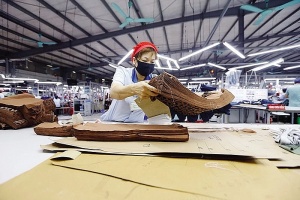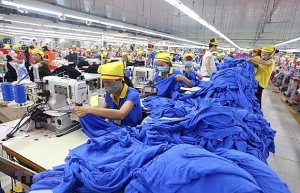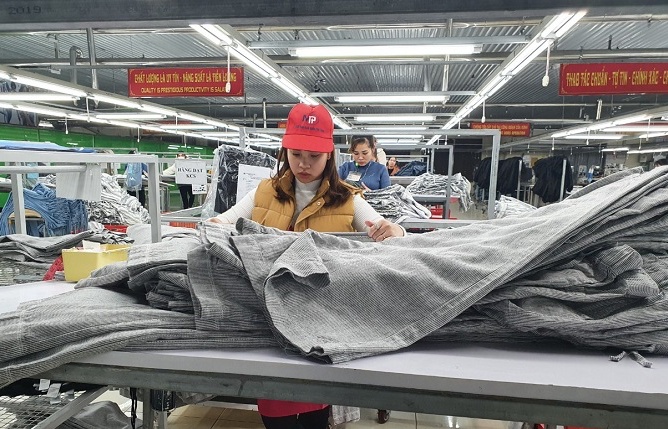Textiles and garments must satisfy importer needs
The global apparel market has shown no indications of recovery yet, so will this contribute to the decline in Vietnam’s textile and garment exports?
 |
| Vu Duc Giang, chairman of the Vietnam Textile and Apparel Association |
Due to the rise in bank lending rates, the disparity in currency rates, and the high share of imported raw materials, businesses are experiencing a very tough time. Orders continue to fall due to poor global buying power.
Today, instead of placing long-term and large-volume purchases, consumers only make orders for a few hundred goods. Since they cannot be active in the market, processing businesses are under greater strain than free-on-board units.
Meanwhile, the most recent projections indicate that the global demand for textile goods in 2023 will decline by around 5 per cent compared to 2022, reaching over $700 billion. This downturn continues to impede the export of apparel from Vietnam. In the first two months of 2023, Vietnam’s textile and garment exports totalled only $4.55 billion, a decrease of 19.6 per cent compared to the same time last year.
In addition, the sector is experiencing a fresh cotton crop, resulting in an increase in production but a decline in demand, which drives down cotton prices. In the first quarter, it is anticipated that cotton prices will range $2.10-2.30 per kg. Now, yarn demand and selling prices are both low, so a large inventory of yarn is raising storage costs and stifling working capital flow.
Might a recovery occur after the first quarter of this year?
Vietnam may meet its textile and garment export goal of $47 billion this year due to a number of variables. Firstly, it is anticipated that the European and American markets will rebound by the end of the second quarter.
The expansion of the sector was also fueled by the availability of indigenous raw materials. This percentage is projected to rise to 55 per cent by 2025. Presently, the sector has the impetus for around 49 per cent of supply.
The free trade agreements (FTAs) that Vietnam has entered, particularly with the EU, will aid the general development of the textile sector. Beginning in 2023, a zero tax rate will be formally applied to a number of Vietnamese exports to the EU, and the roadmap will apply to all exports in the following years.
Therefore, in an open global economy, it is not essential for a single nation to be proactive along the whole supply chain. Yet, if raw materials are not engaged, Vietnam’s participation in the next generation of FTAs becomes meaningless for textiles. Under these, the use of domestic raw resources is one of the requirements for products from Vietnam to be exempt from taxation.
How can you justify the fact that Vietnam still exports yarns, textiles, and accessories every year but still imports a substantial quantity of raw materials?
Vietnam’s garment and textile industry manufacturing is still highly processed. Thus, the export or import of raw materials and accessories is determined by the requirements of customers and brands on the world market.
For the last 10 years, the effort in sourcing local raw materials has reaped dividends for Vietnam, assuring its compliance with FTA origin rules. Vietnam now produces a number of crucial resources, allowing firms to take the lead in a portion of raw materials. Vietnam, for instance, has seven manufacturers making special clothes, six plants producing high-quality khaki and jeans, and the vast majority of ancillary items, such as zippers, are manufactured locally.
Do you believe Vietnam’s textile and garment industry will see more sustainable development if it satisfies the new needs of importers?
Yes. Nowadays, producers face several pressures while main import markets like the United States and the European Union impose numerous additional regulations on imported goods. They necessitate that textiles be recyclable, extremely sustainable, and that the manufacturing process minimises emissions.
The domestic textile industry is adjusting to market and brand needs for sustainable development standards. Producing yarns from organic ingredients, we are transitioning to green manufacturing to satisfy market demands and those of European and American companies. Nowadays, around 30-35 per cent of cotton’s entire production consists of fibres derived from organic materials.
To satisfy the requirement that 20 per cent of electricity come from renewable sources, raw material industries are supplied with solar power. The mobility of the textile industry throughout the global supply chain is a crucial aspect in defining Vietnam’s performance and position in the global market.
 | Exporters urged to proactively deal with drop in orders A new HSBC report has underlined the choppy waters ahead for Vietnamese exports, encouraging industries in the country to plan ahead by eyeing up niche markets and taking on smaller orders to maintain production. |
 | Garment and footwear exports hit new peak at $71 billion Despite orders in the last quarter dropping sharply, garment and footwear production still reported its highest figures of $71 billion in export turnover in 2022. |
 | Textiles and footwear industries face challenges Vietnamese textile and footwear businesses that participate in the supply chain are facing a slew of new possibilities and difficulties, according to industry insiders. |
What the stars mean:
★ Poor ★ ★ Promising ★★★ Good ★★★★ Very good ★★★★★ Exceptional
Related Contents
Latest News
More News
- Businesses ramp up production as year-end orders surge (December 30, 2025 | 10:05)
- Vietjet chairwoman awarded Labour Hero title (December 29, 2025 | 13:06)
- How to unlock ESG value through green innovation (December 29, 2025 | 10:03)
- AI reshapes media and advertising industry (December 29, 2025 | 08:33)
- FPT and GELEX sign deal to develop blockchain tech for global markets (December 29, 2025 | 08:29)
- Vietnam’s GDP forecast to grow by 9 per cent in 2026 (December 29, 2025 | 08:29)
- Women entrepreneurs are key to Vietnam’s economic growth (December 29, 2025 | 08:00)
- Vietnam's top 500 value-creating enterprises announced (December 27, 2025 | 08:00)
- The PAN Group shaping a better future with ESG strategy (December 26, 2025 | 09:00)
- Masan Consumer officially lists on HSX, marking the next phase of value creation (December 25, 2025 | 13:20)

 Tag:
Tag:





















 Mobile Version
Mobile Version